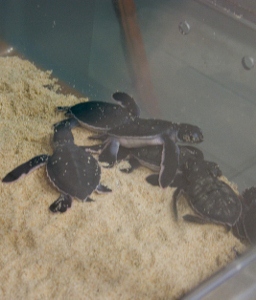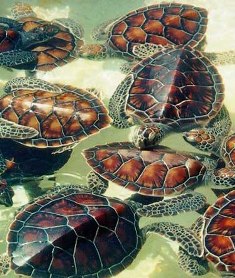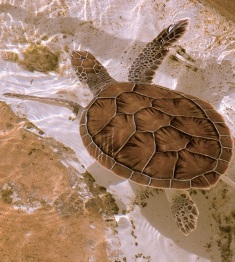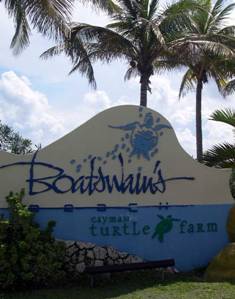Search Results for 'turtle farm'

Turtle farm to release up to 40 hatchlings
 (CNS): Despite the continued breeding problems at the Cayman Islands Turtle Farm officials said that the annual release will still go ahead this year during Pirates Week. The farm said that the release will include 9 yearlings and up to 40 advanced hatchlings, depending on sponsorship. According to a release from the farm the yearlings will be fitted with Passive Integrated Transponders (PIT tags) which are micro transponders encased in a glass case about the size of a large grain of rice. These electronic tags are injected under the skin and can only be detected with a scanner allowing researchers around the world to identify individual animals and better understand migration and nesting patterns.
(CNS): Despite the continued breeding problems at the Cayman Islands Turtle Farm officials said that the annual release will still go ahead this year during Pirates Week. The farm said that the release will include 9 yearlings and up to 40 advanced hatchlings, depending on sponsorship. According to a release from the farm the yearlings will be fitted with Passive Integrated Transponders (PIT tags) which are micro transponders encased in a glass case about the size of a large grain of rice. These electronic tags are injected under the skin and can only be detected with a scanner allowing researchers around the world to identify individual animals and better understand migration and nesting patterns.
Last season, five females tagged and released from the Cayman Turtle Farm in the 1980s, returned to lay their own eggs on Cayman beaches.
The Farm’s release program, known to biologists as ‘headstarting’, has placed over thirty-one thousand green sea turtles into the wild since 1980.
Historically, the Cayman Islands boasted one of the largest green sea turtle populations in the Caribbean and possibly the world. When Christopher Columbus came across the islands in 1503 there were so many turtles he named them ‘Las Tortugas’.
As early as the 17the century the turtles were in serious decline and were already commercially extinct but by 1900, the International Union for the Conservation of Nature (IUCN) deemed the local population to be extinct
According to the Department of Environment, today, there are less than thirty adult female green sea turtles nesting in the Cayman Islands each year. One objective of the headstarting programme is to help replenish the local population of reproducing green sea turtles.
The 31st annual release which has usually take place off seven mile beach will this year take place on Sunday, 13 November at 4pm in the North Sound, off Safe Haven near the North Sound Golf Course. The public is invited to join in and visitors to the Farm, leading up the event, can enter a raffle for a chance to release one of five Hatchlings into the sea.
To take part or find out more about sponsorship opportunities call 949 3894 or email sponsorship@turtle.ky

Turtle farm hopes for improved breeding season
 (CNS): Eleven of the Cayman Turtle Farm’s green turtles laid some 900 eggs in one evening on the facilities beach officials have revealed which they hope is an indication that the breeding rates are about to improve. As the nesting season gets underway Dr. Walter Mustin, Chief Research Officer at the Farm and an expert in hatchery management and aquaculture nutrition has high expectations for at least one of the female turtles which has been breeding for some 19 years. However he pointed out that four of them are making their first attempt at motherhood.
(CNS): Eleven of the Cayman Turtle Farm’s green turtles laid some 900 eggs in one evening on the facilities beach officials have revealed which they hope is an indication that the breeding rates are about to improve. As the nesting season gets underway Dr. Walter Mustin, Chief Research Officer at the Farm and an expert in hatchery management and aquaculture nutrition has high expectations for at least one of the female turtles which has been breeding for some 19 years. However he pointed out that four of them are making their first attempt at motherhood.
“Records show that one of these turtles has laid 88 nests over the past 19 years with 32% hatch success and we have high expectations for her eggs this year,” said Dr Mustin. “In contrast, these are the first eggs that have ever been laid by four of the females. Others in this group have nested before with none of their eggs hatching.”
One of the reasons may be that these breeders are not quiteold enough to lay viable eggs. Green sea turtles in the wild reach sexual maturity only when they are 20-30 years old. Someof our females are laying eggs at the early age of eight years, which is a result of the ample food and protein provided them.
After Hurricane Michelle, over 300 relatively young turtles were placed in the breeder pond to replace the 75% of the breeder herd that was lost to the storm.
“Now, these replacement breeders are 10-15 years old, young by biological standards. Eventually, I expect this younger population sector to come to maturity and produce more and more eggs that actually hatch,” Dr. Mustin explained.
Meanwhile, research aimed at improving sea turtle hatch rates continues at the farm on multiple fronts the facility has revealed. A custom breeder diet is being formulated that more accurately reflects and mimics the nutritional composition of the green sea turtle’s wild diet which is turtle grass, liver sponge, and marine algae.
“The causes of infertility are being examined. All eggs that do not hatch are staged to determine the state of fertility and/or development. New incubation techniques that reduce early hatching mortality are also being implemented,” Dr. Mustin added.
The ultimate goal of the Cayman Turtle Farm team is to be able to release more and more green sea turtles.
“As our hatch rates improve, so will our ability to release greater numbers to the wild,” the doctor stated. “We know from tagging studies on turtles released from the Cayman Turtle Farm that our released turtles are not only surviving and travelling throughout the Caribbean, but that turtles that we released in the 1980s are now sexually mature and returning to Cayman beaches to lay their own eggs.”
Of the 30-60 green sea turtles that the Department of Environment estimates visited our beaches last season to lay eggs, at least five of them were released as yearlings from the Cayman Turtle Farm some 25 years earlier.
Turtle Farm Managing Director Tim Adam said he was very pleased by the successful nesting, which showed how well the breeding programme was advancing.
“We are very excited with the activity we saw on this one night; and hope that it is indicative of future breeding successes,” he said. “Our team of experts continue to develop and try new methods and conduct scientific research that will boost hatch rates as well…. The efforts of Dr. Mustin and his staff and their commitment to improving hatch rates will ensure that as our females reach breeding age they will be able to lay greater numbers of viable eggs. Their work is vital to our mission to promote conservation of the green sea turtle.”

Captured croc becomes turtle farm performer
 (CNS): The Cayman Turtle Farm has revealed that a nine foot long crocodile which was captured in 2006 in North Side has become a permanent exhibit at the facility, allegedly entertaining visitors at feeding times. “Smiley”, as the female crocodile has been called, is now being housed alone in a purpose-built enclosure, named Smiley’s Saltwater Lounge. The farm said the creature “has proven very popular” since being introduced last month to the facility’s wildlife encounter. The croc is believed to be a mix of Cuban and American crocodiles and therefore was unsuitable for release back into the wild.
(CNS): The Cayman Turtle Farm has revealed that a nine foot long crocodile which was captured in 2006 in North Side has become a permanent exhibit at the facility, allegedly entertaining visitors at feeding times. “Smiley”, as the female crocodile has been called, is now being housed alone in a purpose-built enclosure, named Smiley’s Saltwater Lounge. The farm said the creature “has proven very popular” since being introduced last month to the facility’s wildlife encounter. The croc is believed to be a mix of Cuban and American crocodiles and therefore was unsuitable for release back into the wild.
The farm said that visitors are able to watch three weekly feeding shows where Smiley rises out of the water to snare the food dangled above her. Cayman Turtle Farm Managing Director Tim Adam said the animal programmes staff had worked hard to get to know “this fascinating creature" over the four-plus years since Smiley had been captured and taken to the farm before becoming an exhibit.
“She is quite a character,” Adam said. “Now visitors to the Turtle Farm can experience a bit of her behaviour first-hand and up close.”
Over the years there have been, and continue to be, several sightings of crocodiles in the Cayman Islands. Although the original indigenous caiman is believed to be extinct, there appear to be at least two crocodiles living here in the wild. Smiley was first spotted and eventually caught inthe waters off the Queen’s Highway in North Side at the end of 2006.
Once it was discovered that Smiley was a mix of the American and Cuban crocodile, the Cayman Turtle Farm offered her a home because, it said, environmentalists consider it undesirable to release hybrid animals into the wild. Since Smiley was moved to the farm she has been the subject of study by staff, who have also been training her, and she has now become an official exhibit.
In a release the farm said she can follow a pole target and launch out of the water to jump for her food. The enclosure affords onlookers a great view through Plexiglas panels that keep the visitors safe only a few feet away from the crocodile. A sign at the enclosure also offers information about Smiley.
Geddes Hislop, the Curator for the Terrestrial and Education Programme at the Turtle Farm, offers visitors a short presentation on Smiley and crocodiles. “We hope that this new exhibit, which offers a great opportunity to watch Smiley, will both entertain and educate visitors as we highlight the significance of the crocodile in Cayman’s history,” Hislop said.
The islands’ name “Cayman” is an Anglicised version of the word Caiman, the Spanish word for crocodile which was derived from the language of the indigenous peoples that inhabited Cuba and the Bahamas. Because of the abundance of sea turtles at the time of discovery in 1503 Columbus named the islands “Las Tortugas” but the islands were re-named “Caimanes” as far back as the 1530’s due to the large numbers of these crocodiles reported by colonial explorers in those days.

Turtle Farm can sustain discount sale say officials
 (CNS): While officials from the Cayman Turtle Farm have claimed that the significant increase in the price of meat was essential to the facility’s survival and future meat production it is continuing on with the Christmas sale prices as it says it can sustain them at present. In a statement released Wednesday afternoon the farm said turtle meat and menavelin would remain at discount prices for those buying in bulk throughout this month. Cayman Turtle Farm Managing Director Tim Adam said, not surprisingly, that the holiday-season price cuts had proven tremendously popular and a decision was made to keep them at discounted levels. He explained that the farm aimed to monitor prices and production levels and reduce the cost of the meat whenever possible.
(CNS): While officials from the Cayman Turtle Farm have claimed that the significant increase in the price of meat was essential to the facility’s survival and future meat production it is continuing on with the Christmas sale prices as it says it can sustain them at present. In a statement released Wednesday afternoon the farm said turtle meat and menavelin would remain at discount prices for those buying in bulk throughout this month. Cayman Turtle Farm Managing Director Tim Adam said, not surprisingly, that the holiday-season price cuts had proven tremendously popular and a decision was made to keep them at discounted levels. He explained that the farm aimed to monitor prices and production levels and reduce the cost of the meat whenever possible.
“Understanding the traditional value and the sentimental place of turtle meat in Cayman culinary traditions, we are happy that we can continue commercial supplies to the community, while simultaneously maintaining our management programmes for green sea turtles,” he said.
Adam said the lower prices would remain in effect at least for the month of January on a first-come, first-served basis.
Prices are now set at $12 per pound for stewing meat and $9 per pound for menavelin. Turtle steak is also discounted to $20.25 per pound. Purchasers are required to buy in 5-pound lots.
The holiday price reductions discounted 2010 increases that had pushed turtle stew from previous long-standing levels of $5.40 per pound to $16, and menavelin from $4 to $12. The price hikes had formedpart of efforts to reduce consumption and enable replenishment of the farm’s turtle stocks, the farm had said.
Adam said that the increases through 2010 had assisted in the management of the 8,000-member herd because of a drop in demand and as a result supplies remained sustainable. “To maintain supplies at sustainable levels, we need to continue careful management, and we think that, by and large, the community both understands and supports our efforts,” he said.
“We will monitor demand at these new prices to determine what further price adjustments may be necessary from time to time. Our intention is to adjust prices periodically so as to better balance demand against the sustainable amount we can supply. That will give us the best opportunity to continue providing turtle meat to our valued customers in the Cayman Islands,” he said.

Cayman Turtle Farm speaks
The Cayman Turtle Farm appears to elicit an emotional response whenever anyone discusses it. Recent posts on CNS in response to a story about our November turtle release are an example of this. Some of the comments suggest a lack of understanding of what actually occurs at the farm. The Turtle Farm represents both a unique wildlife-conservation project and a commercial-breeding enterprise.
Housed, in a sense, under the same roof, the two functions at times appear contradictory, which is precisely where the controversy usually arises. From the farm’s inception however, the philosophy of “conservation through commercialisation” has been both inherent and explicit.
An analogy may help illustrate the logic: Consider the reaction should chicken farms suddenly vanish. Farming fowl for meat and eggs is widely accepted, and has been for thousands of years. An enormous source of protein in human diets would be severely curtailed if chicken meat and eggs were no longer produced.
The fundamental difference is the acceptability of farming chickens for food as opposed to farming turtles for food. The differences in acceptability, however, are mostly chronological and geopolitical: Chickens have been domesticated and farmed for thousands of years across global cultures; farming of sea turtles only started four decades ago — and only in one place: Grand Cayman.
We might point to another, perhaps closer, analogy: buffalo farming. One might argue buffalo farming helps conserve the species, expanding its population. One could choose almost any commonly farmed animal; a similar logic emerges.
Conservation and commercialisation are, however, frequently compatible: up to a point, of course. Annual turtle harvests must be carefully controlled, ensuring they are sustainable, measured against the numbers of new hatchlings entering the first stages of the farm herd — and allowing for the quantities of yearlings to be released.
Starting from early 2010, Cayman Turtle Farm has adjusted the price of turtle products to align demand and a sustainable annual harvest. What may be overlooked, however, is that even the sale of turtle meat has a positive conservation impact because it greatly reduces poaching in the wild, which is often otherwise uncontrollable, both in terms of numbers and indiscriminate in terms of age and sex.
Those who have been here since the early days of scuba diving will tell you that the chance of seeing a turtle on a dive in the Cayman Islands has improved significantly through the years. The increased numbers of turtles sighted aren’t just those released from the farm; many are in our waters because the incidence of turtles being caught and taken from the sea around our islands has greatly declined. The incentives for poaching have diminished since the farm has made turtle meat available locally. Since the farmed meat also supplies Cayman Brac and Little Cayman, the conservation benefits also extend to those wild populations.
The unique management programmes addressing both conservation and commercial activities also enable better understanding and care for the turtles, their life cycle and their environment in the wild or in captivity.
Another misunderstanding that looms large is that the farm’s conservation efforts are limited to the turtles that have been released annually during Pirate’s Week.
The farm has placed more than 31,000 endangered green sea turtles into the wild since its 1968 founding. Some of those numbers were hatchlings and others were yearlings. Further information on the farm’s current release program may yield better understanding of at least one of the reasons for recent lower numbers.
Hatchlings, due to their smaller size compared to yearlings, are much more vulnerable to predators and other hazards. Unsurprisingly, hatchlings have a much lower chance of survival to adulthood. In recent years, Cayman Turtle Farm has released only turtles that are at least 1 year old. In addition, we now release them only after having carefully selected, quarantined and trained the turtles, gradually weaning them from hand-fed food, while acclimatising them to forage in our salt-water Turtle Lagoon, in surroundings that resemble the wild environment as closely as possible.
That process takes at least three months and a large number of extra man-hours of expert attention for every group of turtles to be released. This places practical limits on the quantities we can release each year, but we believe these meticulous protocols give the yearlings a better chance of survival to become parents in the wild.
But the turtle release program is only one part of our contribution to conservation.
Another has been the farm’s research efforts, producing approximately 100 scientific papers that have been published or presented since 1968. These papers have surveyed a range of topics regarding the care and husbandry of sea turtles.
Several new studies are under way: One planned for 2011 in collaboration with a university in the UK involves a new way of estimating the age of sea turtles. This study would not be possible without the Turtle Farm’s unique stock of turtles and the broad range of their accurately known ages. Such a resource exists nowhere else in the world.
Other projects include a study in partnership with a US pharmaceutical firm, a study in collaboration with a US university, and a hatchery incubation study designed to increase the survival of hatchlings.
Another issue frequently broached is the return of released turtles to the Cayman Islands.
After reaching maturity, which can take 20 years or more, nesting females seek to lay their eggs on the same beach — or as close as they can come — from which they originally left to enter the sea. We know that last year at least one female released close to two decades ago from the farm nested on a local beach; this year about half-a-dozen farm-released females were spotted nesting here.
Several other green sea turtle females also nested on the island’s beaches this year: Because trained spotters did not see them all, however, it is uncertain how many of those started at the farm. It is perfectly reasonable, though, to assume that as more turtles, released years ago, reach nesting age, many will return to Cayman beaches. While we do not mark every turtle we release, we are able to extrapolate trends from those that have been strategically tagged.
Finally, we are aware of concerns about what looks like overcrowded tanks at the farm. In the past several days, as part of our annual inventory process, display tank stocking rates were adjusted downward to reflect weight gain.
Our turtles range in size from 6 ounces to 600 pounds, apportioned among specifically designated tanks. Visitors are able to observe every stage of growth and development, including the release of the selected one-year-old acclimated animals.
We encourage visitors; we encourage interest in what we are doing, and we look forward to seeing Cayman News Service readers at the Cayman Turtle Farm: Island Wildlife Encounter.
Tim Adam is the managing director of the Cayman Turtle Farm

Turtle farm goes back to roots
 (CNS): The management team at the Turtle Farm says it is dropping the name Boatswain’s Beach and returning to the original name of The Cayman Turtle Farm. Announcing a rebranding of the facility this morning, Managing Director Tim Adam said it was about returning to a simpler more relevant title for both locals and overseas visitors. He added that the rebrand was the start of the next phase of the facility’s development. With the cost cutting exercise over, the farm crew was focusing on attracting more visitors. Adam, who has been in post since January this year and already has a reputation for tackling the difficult issues, spearheaded the move for a return to the original name, which is likely to receive popular support. (Photo Dennie WarrenJr)
(CNS): The management team at the Turtle Farm says it is dropping the name Boatswain’s Beach and returning to the original name of The Cayman Turtle Farm. Announcing a rebranding of the facility this morning, Managing Director Tim Adam said it was about returning to a simpler more relevant title for both locals and overseas visitors. He added that the rebrand was the start of the next phase of the facility’s development. With the cost cutting exercise over, the farm crew was focusing on attracting more visitors. Adam, who has been in post since January this year and already has a reputation for tackling the difficult issues, spearheaded the move for a return to the original name, which is likely to receive popular support. (Photo Dennie WarrenJr)
Turtle Farm to release baby Cayman Parrot
(CNS): Officials at the Cayman Turtle Farm are turning their attention to the release of a very different kind of creature than the one most frequently at the centre of the farm’s wild release programme. Staff are currently preparing to release a Cayman Parrot that has recently fledged in the aviary. The baby parrot was hatched two months ago in early June to Leo, a male parrot who has called the farm home since the 1980s and Sweetpea, a wild parrot rescued from a poacher and donated to the Turtle Farm’s aviary by Cayman Wildlife Rescue. The count down to the parrots release will see the young bird isolated from human contact and a weaning from commercial feed.

Turtle Farm cash injection up
 (CNS): Despite job cuts and an increase in the price of turtle meat, Boatswain Beach, Cayman Turtle Farm has still received a government subsidy of over $9.6 million. The increase of more than half a million on last year’s cash injection was revealed in the 2010/11 budget documents. According to the managing director, the demand for meat at the farm has fallen as a result of the price increase. This reduction in demand has relieved the pressure on the facility, which is struggling with a number of problems related to the breeding programme. Tim Adam explained some of the issues during Monday’s session of Finance Committee when legislators agreed to the farm’s $9,688,889 equity investment. (Photo Dennie Warren Jr)
(CNS): Despite job cuts and an increase in the price of turtle meat, Boatswain Beach, Cayman Turtle Farm has still received a government subsidy of over $9.6 million. The increase of more than half a million on last year’s cash injection was revealed in the 2010/11 budget documents. According to the managing director, the demand for meat at the farm has fallen as a result of the price increase. This reduction in demand has relieved the pressure on the facility, which is struggling with a number of problems related to the breeding programme. Tim Adam explained some of the issues during Monday’s session of Finance Committee when legislators agreed to the farm’s $9,688,889 equity investment. (Photo Dennie Warren Jr)
Adam said there were no plans to reduce the price of meat in the near future as it was clear demand was sensitive to price and until the farm could improve the hatchling rates and their subsequent survival and lower the productions costs the farm had to keep demand down.

Turtle Farm claims renewed hope with visitor increase
 (CNS): The home of the Cayman Islands Turtle Farm, Boatswain’s Beach, is claiming that its latest statistics show that both visitors and revenue have improved from the previous year, offering some encouragement about the viability of the controversial attraction. The farm said that when it compared the results from June 2008–April 2009 to the period of June 2009-April 2010, tours had increased at Boatswain’s Beach by some 2% and revenue from the tours was up almost $250,000 or 9%. Combined with the recent cost cutting measures introduced at the facility, the management and Board of Directors said this gives renewed hope about the long-term future of the attraction.
(CNS): The home of the Cayman Islands Turtle Farm, Boatswain’s Beach, is claiming that its latest statistics show that both visitors and revenue have improved from the previous year, offering some encouragement about the viability of the controversial attraction. The farm said that when it compared the results from June 2008–April 2009 to the period of June 2009-April 2010, tours had increased at Boatswain’s Beach by some 2% and revenue from the tours was up almost $250,000 or 9%. Combined with the recent cost cutting measures introduced at the facility, the management and Board of Directors said this gives renewed hope about the long-term future of the attraction.

Turtle farm cuts staff in face of subsidy reduction
 (CNS): The first job casualties of government expenditure cuts have occurred at the Cayman Turtle Farm. Although the exact details of which jobs have been cut and how many have not been revealed the farm confirmed on Friday that a number of people had been laid off. The farm began trying to reduce its subsidy requirement by increasing the cost of turtle meat earlier this year to reflect production costs and it says it has also streamlined various processes aimed at increasing efficiencies. Now it the farm says it has bee forced to reduce personnel costs, which represent a very large percentage of the company’s budget.
(CNS): The first job casualties of government expenditure cuts have occurred at the Cayman Turtle Farm. Although the exact details of which jobs have been cut and how many have not been revealed the farm confirmed on Friday that a number of people had been laid off. The farm began trying to reduce its subsidy requirement by increasing the cost of turtle meat earlier this year to reflect production costs and it says it has also streamlined various processes aimed at increasing efficiencies. Now it the farm says it has bee forced to reduce personnel costs, which represent a very large percentage of the company’s budget.